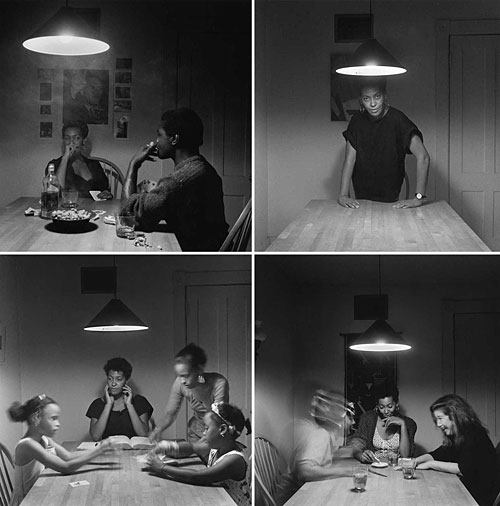
Storytelling is fundamental in Carrie Mae Weems’s work. For three decades, Weems has created socially engaged, conceptual work in photography, video, mixed media and installation. Using narratives both personal and universal, Weems addresses what scholar Henry Louis Gates Jr. calls “the complex web of gender, race, sexuality, class, family and community that catches us all.”
On April 20,Carrie Mae Weems is born in Portland, Oregon
She is the second child born to Carrie Polk and Myrlie Weems and is a Contemporary photographer. At the age of 16 she gave birth to her first and only child, a daughter named Faith C. Weems. Later that year she moved out of her parent's home and soon relocated to San Francisco to study modern dance with Anna Halprin at a workshop Halprin had started with several other dancers, as well as the artists John Cage and Robert Morris. She decided to continue her arts schooling and attended the California Institute of the Arts, Valencia. She graduated at the age of 28 with her BA in 1981 and an MFA in Photography from the University of California, San Diego in 1984. From 1984 until 1987, Weems studied folklore at the University of California, Berkeley.
She is the second child born to Carrie Polk and Myrlie Weems and is a Contemporary photographer. At the age of 16 she gave birth to her first and only child, a daughter named Faith C. Weems. Later that year she moved out of her parent's home and soon relocated to San Francisco to study modern dance with Anna Halprin at a workshop Halprin had started with several other dancers, as well as the artists John Cage and Robert Morris. She decided to continue her arts schooling and attended the California Institute of the Arts, Valencia. She graduated at the age of 28 with her BA in 1981 and an MFA in Photography from the University of California, San Diego in 1984. From 1984 until 1987, Weems studied folklore at the University of California, Berkeley.
While in her early twenties, Carrie Mae Weems was politically active in the labor movement as a union organizer. Her first camera, which she received as a birthday gift from her then boyfriend,was used for politics rather than for artistic purposes. She was inspired to pursue photography only after she came across The Black Photography Annual, a book of images by African-American photographers. This book contained the work of photographers Shawn Walker, Beuford Smith, Anthony Barboza, Ming Smith, Adger Cowans, and Roy DeCarava, which Weems found inspiring. This led her to New York, and the Studio Museum in Harlem, where she began to meet other artists and photographers such as Frank Stewart and Coreen Simpson, and they began to form a community. In 1976 Weems took a photography class at the Museum taught by Dawoud Bey. She returned to San Francisco, but lived bi-coastally and was involved with the Studio Museum and a community of photographers in New York.
She is best known for creating installations using photographs, text, captions, and audio recordings. Weems'' work often confronts viewers with the issues of racism, identity, and gender and frequently explores these themes through the lenses of both personal and national history. Weems cites Langston Hughes and Zora Neale Hurston as writers who had a significant impact on her interests and artistic style. In 1983,Carrie Mae Weems completed her first collection of photographs,text, and spoken word called,Family Pictures and Stories. The images told the story of her family,and she has said that in this project she was trying to explore the movement of black families out of the South and into the North, using her family as a model for the larger theme. Her next series, called Ain't Jokin', was completed in 1988. It focused on racial jokes and internalized racism. Another series called American Icons, completed in 1989, also focused on racism. Weems has said that throughout the 1980s she was turning away from the documentary photography genre, instead "creating representations that appeared to be documents but were in fact staged" and also "incorporating text, using multiples images, diptychs and triptychs, and constructing narratives." Gender issues were the next focal point for Carrie Mae Weems. It was the topic of one of her most well known collections called The Kitchen Table series which was completed in 1990. About Kitchen Table and Family Pictures and Stories, Weems has said, "I use my own constructed image as a vehicle for questioning ideas about the role of tradition, the nature of family, monogamy, polygamy, relationships between men and women,between women and their children,and between women and other women—underscoring the critical problems and the possible resolves." She has expressed disbelief and concern about the exclusion of images of the black community,particularly black women,from the popular media,and aims to represent these excluded subjects and speak to their experience through her work. Other series created by Weems include: the Sea Island Series (1991-92),the Africa Series (1993),From Here I Saw What Happened and I Cried (1995-96),Who What When Where (1998),Ritual & Revolution (1998),the Louisiana Project (2003),Roaming (2006),and the Museum Series, which she began in 2007.She currently lives and works in upstate New York.
In her almost 30 year career,Carrie Mae Weems has won numerous awards. She was named Photographer of the Year by the Friends of Photography. In 2005, she was awarded the Distinguished Photographer's Award in recognition of her significant contributions to the world of photography. Her talents have also been recognized by numerous colleges, including Harvard University and Wellesley College, with fellowships, artist-in-residence and visiting professor positions. She was awarded a MacArthur Foundation Fellowship in 2013


Carrie Mae Weems: “The Kitchen Table Series"

http://radicalpresenceny.org/?page_id=379
https://www.artnet.com/artists/carrie+mae-weems/
http://carriemaeweems.net/
http://en.wikipedia.org/wiki/Carrie_Mae_Weems
No comments:
Post a Comment